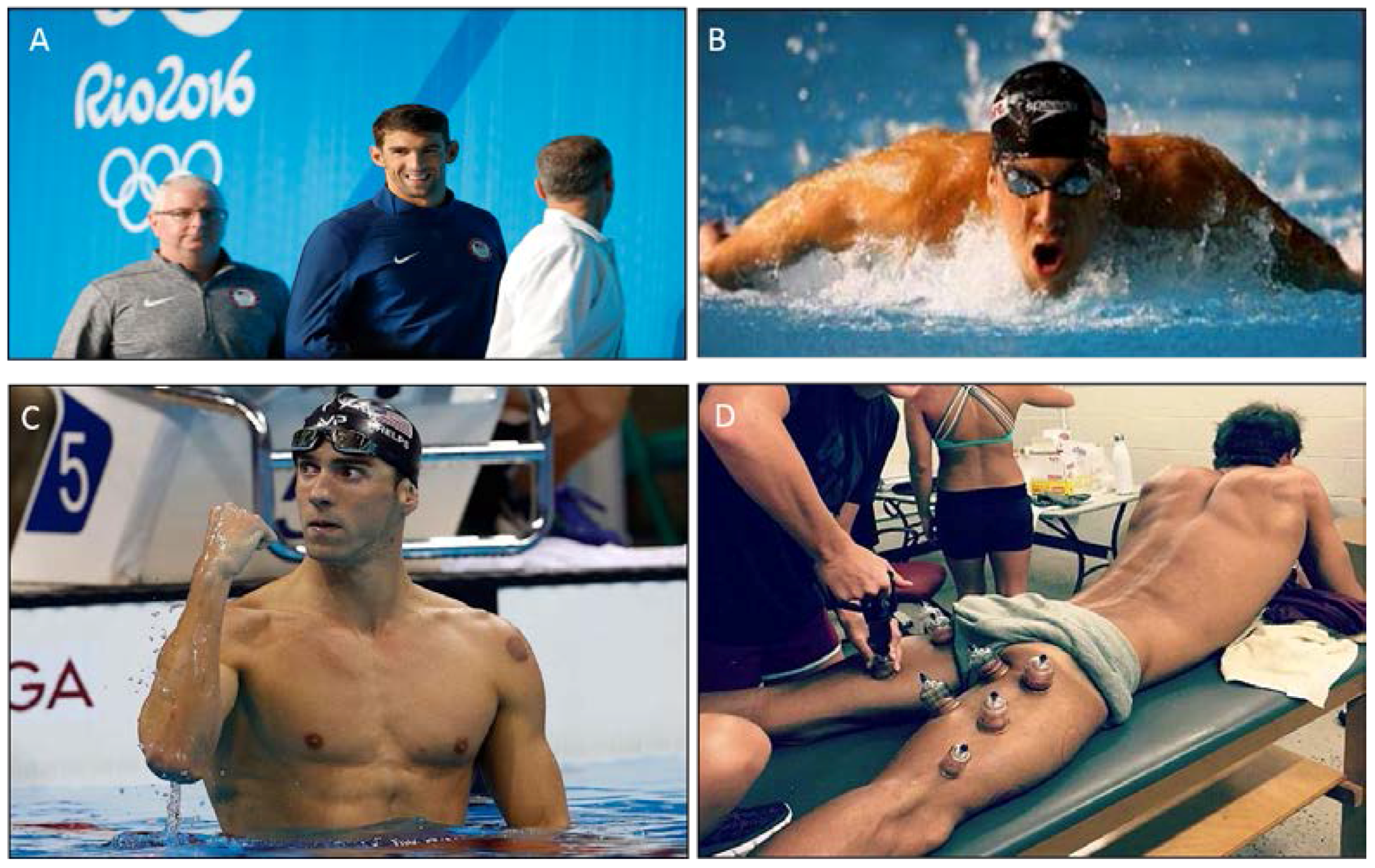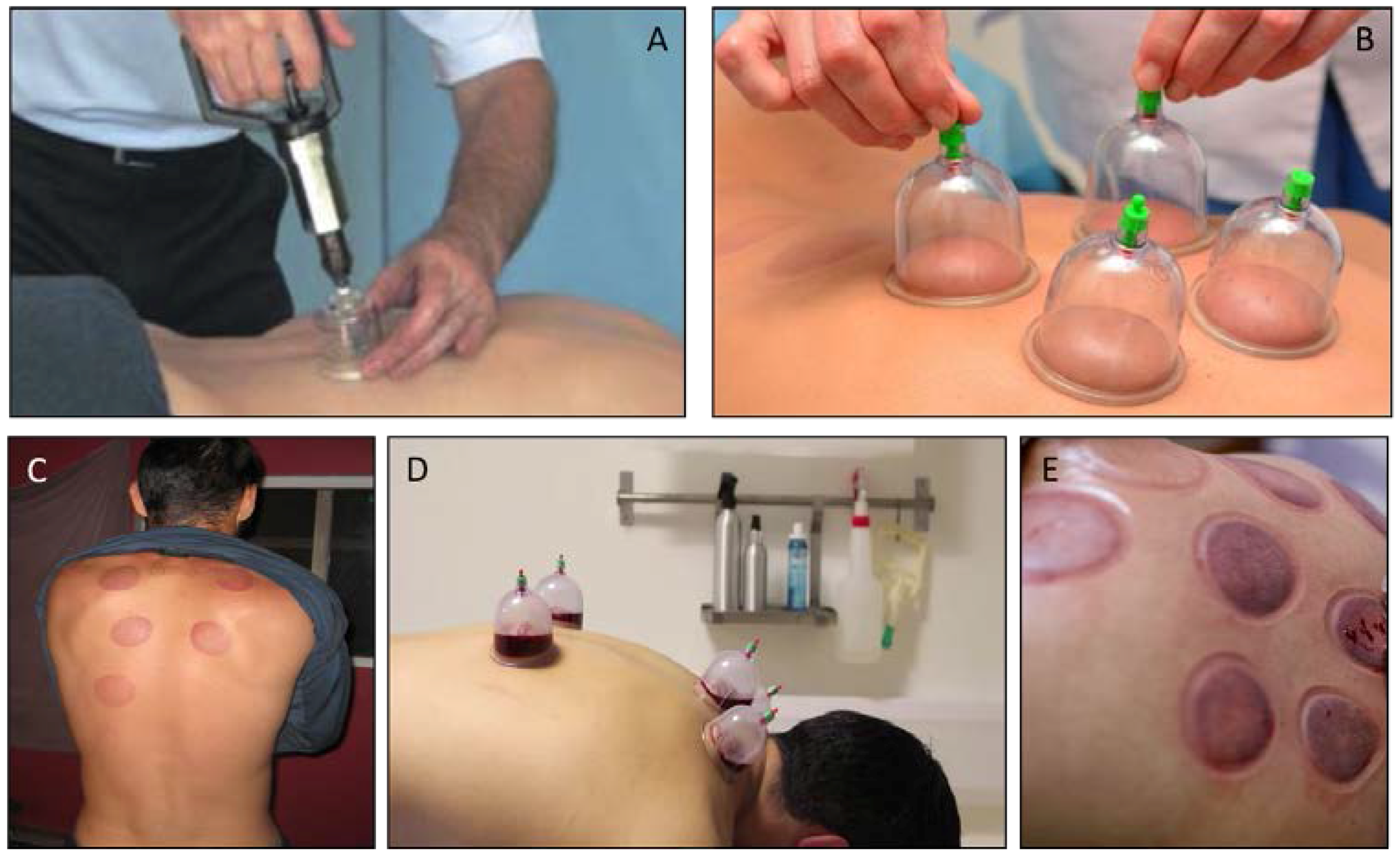Could Cupping Therapy Be Used to Improve Sports Performance?
Abstract
:1. Introduction
2. Short Overview of the Cupping Therapy Mechanism
3. Conclusions
Acknowledgments
Conflicts of Interest
References
- Castrogiovanni, P.; di Giunta, A.; Guglielmino, C.; Roggio, F.; Romeo, D.; Fidone, F.; Imbesi, R.; Loreto, C.; Castorina, S.; Musumeci, G. The effects of exercise and kinesio tape on physical limitations in patients with knee osteoarthritis. J. Funct. Morphol. Kinesiol. 2016, 1, 355–368. [Google Scholar] [CrossRef]
- Aguilar-Ferrándiz, M.E.; Castro-Sánchez, A.M.; Matarán-Peñarrocha, G.A.; García-Muro, F.; Serge, T.; Moreno-Lorenzo, C. Effects of kinesio taping on venous symptoms, bioelectrical activity of the gastrocnemius muscle, range of ankle motion, and quality of life in postmenopausal women with chronic venous insufficiency: A randomized controlled trial. Arch. Phys. Med. Rehabil. 2013, 94, 2315–2328. [Google Scholar] [CrossRef] [PubMed]
- Williams, S.; Whatman, C.; Hume, P.A.; Sheerin, K. Kinesio taping in treatment and prevention of sports injuries: A meta-analysis of the evidence for its effectiveness. Sports Med. 2012, 42, 153–164. [Google Scholar] [CrossRef] [PubMed] [Green Version]
- Gao, L.W. Practical Cupping Therapy; Academy Press: Beijing, China, 2004. (In Chinese) [Google Scholar]
- Chirali, I.Z. The cupping procedure. In Traditional Chinese Medicine Cupping Therapy; Chirali, I.Z., Ed.; Churchill Livingstone: London, UK, 1999. [Google Scholar]
- Zhao, X.M. Ben Cao Gang Mu Shi Yi; People’s Medical Publishing House: Beijing, China, 1963. (In Chinese) [Google Scholar]
- El Sayed, S.M.; Mahmoud, H.S.; Nabo, M.M.H. Medical and scientific bases of wet cupping therapy (Al-hijamah): In light of modern medicine and prophetic medicine. Altern. Integr. Med. 2013, 2. [Google Scholar] [CrossRef]
- Cao, H.; Liu, J.; Lewith, G.T. Traditional Chinese Medicine for treatment of fibromyalgia: A systematic review of randomized controlled trials. J. Altern. Complement. Med. 2010, 16, 397–409. [Google Scholar] [CrossRef] [PubMed]
- Cao, H.; Han, M.; Li, X.; Dong, S.; Shang, Y.; Wang, Q.; Xu, S.; Liu, J. Clinical research evidence of cupping therapy in China: A systematic literature review. BMC Complement. Altern. Med. 2010, 10. [Google Scholar] [CrossRef] [PubMed]
- Cho, H.W.; Hwang, E.H.; Lim, B.; Heo, K.H.; Liu, J.P.; Tsutani, K.; Lee, M.S.; Shin, B.C. How current clinical practice guidelines for low back pain reflect traditional medicine in East Asian countries: A systematic review of clinical practice guidelines and systematic reviews. PLoS ONE 2014, 9, e88027. [Google Scholar] [CrossRef] [PubMed]
- Chirali, I.Z. Benefits of cupping therapy. In Traditional Chinese Medicine Cupping Therapy; Chirali, I.Z., Ed.; Churchill Livingstone: London, UK, 1999. [Google Scholar]
- Chirali, I. Traditional Chinese Medicine Cupping Therapy; Elsevier Churchill Livingston: Philadelphia, PA, USA, 2007. [Google Scholar]
- Manz, A. The Art of Cupping; Thieme: Stuttgart, Germany, 2009. [Google Scholar]
- Ahmadi, A.; Schwebel, D.C.; Rezaei, M. The efficacy of wet-cupping in the treatment of tension and migraine headache. Am. J. Chin. Med. 2008, 36, 37–44. [Google Scholar] [CrossRef] [PubMed]
- Lauche, R.; Cramer, H.; Hohmann, C.; Choi, K.E.; Rampp, T.; Saha, F.J.; Musial, F.; Langhorst, J.; Dobos, G. The effect of traditional cupping on pain and mechanical thresholds in patients with chronic nonspecific neck pain: A randomised controlled pilot study. Evid. Based Complement. Altern. Med. 2012, 2012. [Google Scholar] [CrossRef] [PubMed]
- Farhadi, K.; Schwebel, D.C.; Saeb, M.; Choubsaz, M.; Mohammadi, R.; Ahmadi, A. The effectiveness of wetcupping for nonspecific low back pain in Iran: A randomized controlled trial. Complement. Ther. Med. 2009, 17, 9–15. [Google Scholar] [CrossRef] [PubMed]
- Kim, J.I.; Lee, M.S.; Lee, D.H.; Boddy, K.; Ernst, E. Cupping for treating pain: A systematic review. Evid. Based Complement. Altern. Med. 2011, 2011, 467014. [Google Scholar] [CrossRef] [PubMed]
- Ludtke, R.; Albrecht, U.; Stange, R.; Uehleke, B. Brachialgia paraesthetica nocturna can be relieved by “wet cupping”—Results of a randomised pilot study. Complement. Ther. Med. 2006, 14, 247–253. [Google Scholar] [CrossRef] [PubMed]
- Michalsen, A.; Bock, S.; Ludtke, R.; Rampp, T.; Baecker, M.; Bachmann, J.; Langhorst, J.; Musial, F.; Dobos, G.J. Effects of traditional cupping therapy in patients with carpal tunnel syndrome: A randomized controlled trial. J. Pain 2009, 10, 601–608. [Google Scholar] [CrossRef] [PubMed]
- Cao, H.; Zhu, C.; Liu, J. Wet cupping therapy for treatment of herpes zoster: A systematic review of randomized controlled trials. Altern. Ther. Health Med. 2010, 16, 48–54. [Google Scholar] [PubMed]
- Weerapong, P.; Hume, P.A.; Kolt, G.S. The mechanisms of massage and effects on performance, muscle recovery and injury prevention. Sports Med. 2005, 35, 235–256. [Google Scholar] [CrossRef] [PubMed]
- Johnston, V.; Jimmieson, N.L.; Jull, G.; Souvlis, T. Quantitative sensory measures distinguish office workers with varying levels of neck pain and disability. Pain 2008, 137, 257–265. [Google Scholar] [CrossRef] [PubMed]
- Treede, R.D.; Rolke, R.; Andrews, K.; Magerl, W. Pain elicited by blunt pressure: Neurobiological basis and clinical relevance. Pain 2002, 98, 235–240. [Google Scholar] [CrossRef]


© 2016 by the author; licensee MDPI, Basel, Switzerland. This article is an open access article distributed under the terms and conditions of the Creative Commons Attribution (CC-BY) license (http://creativecommons.org/licenses/by/4.0/).
Share and Cite
Musumeci, G. Could Cupping Therapy Be Used to Improve Sports Performance? J. Funct. Morphol. Kinesiol. 2016, 1, 373-377. https://doi.org/10.3390/jfmk1040373
Musumeci G. Could Cupping Therapy Be Used to Improve Sports Performance? Journal of Functional Morphology and Kinesiology. 2016; 1(4):373-377. https://doi.org/10.3390/jfmk1040373
Chicago/Turabian StyleMusumeci, Giuseppe. 2016. "Could Cupping Therapy Be Used to Improve Sports Performance?" Journal of Functional Morphology and Kinesiology 1, no. 4: 373-377. https://doi.org/10.3390/jfmk1040373
APA StyleMusumeci, G. (2016). Could Cupping Therapy Be Used to Improve Sports Performance? Journal of Functional Morphology and Kinesiology, 1(4), 373-377. https://doi.org/10.3390/jfmk1040373





